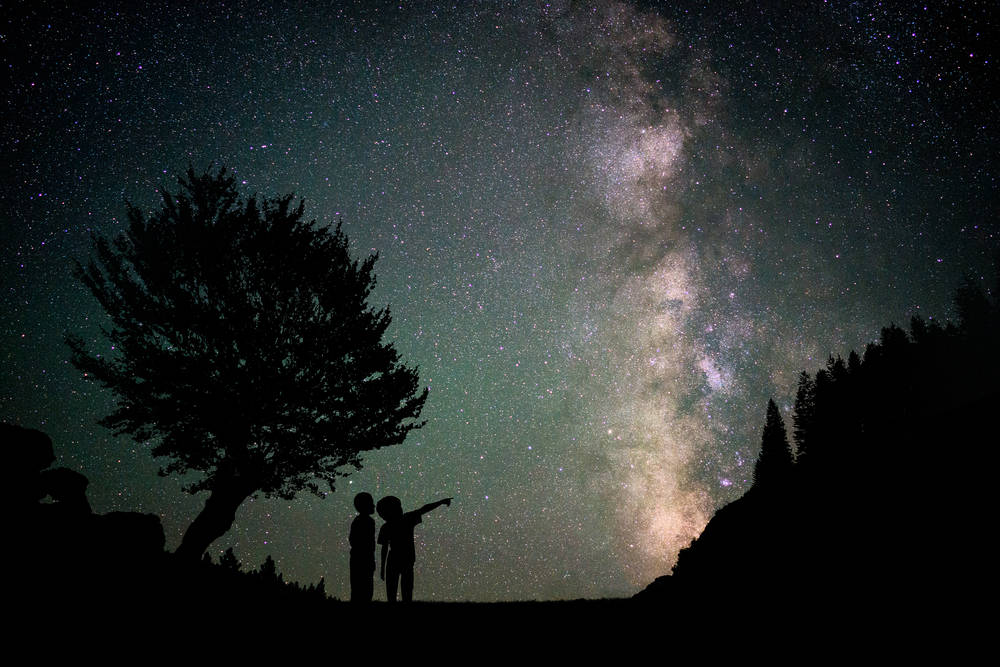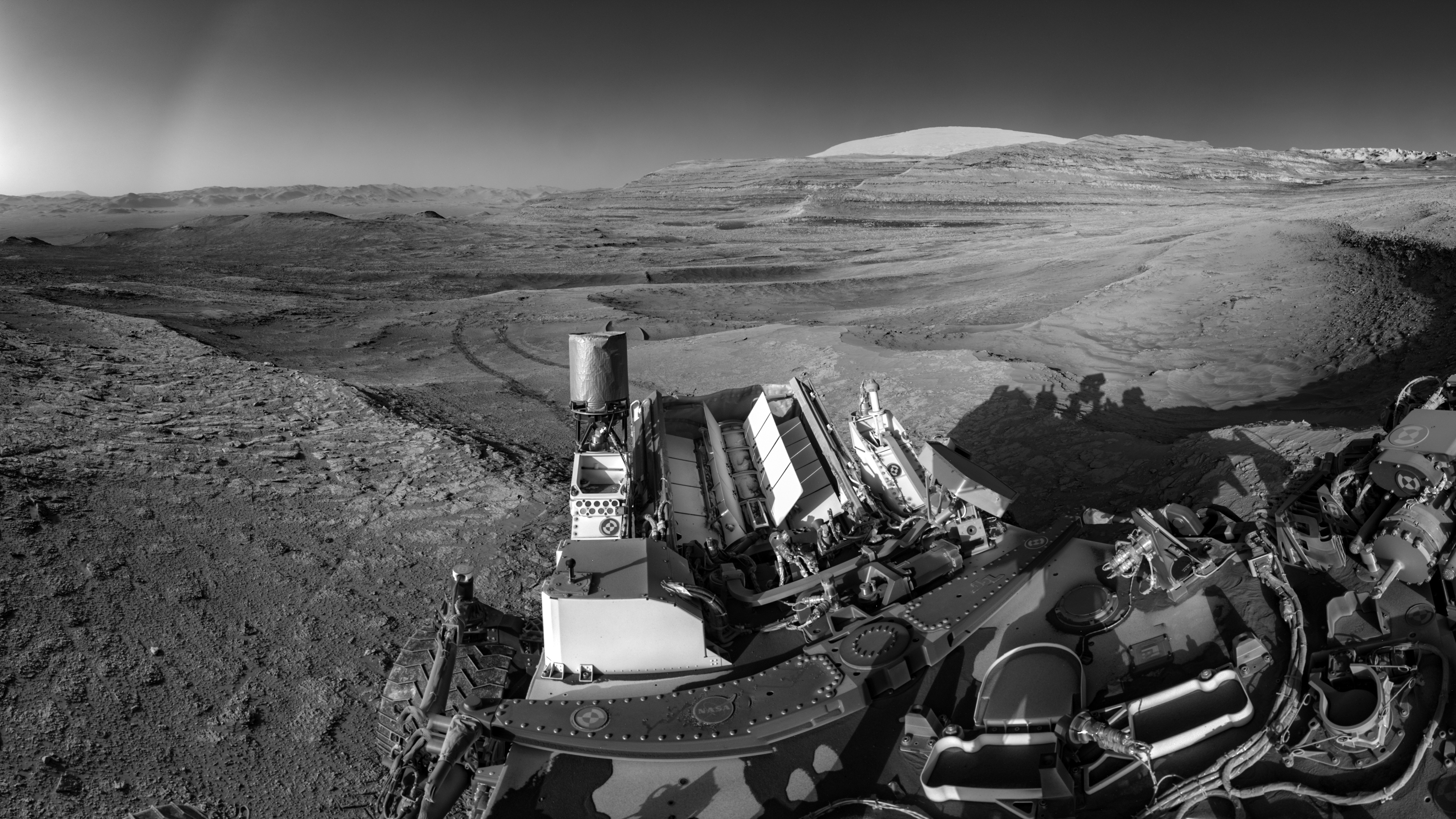Sign up for the Starts With a Bang newsletter
Travel the universe with Dr. Ethan Siegel as he answers the biggest questions of all.
Out there in the Universe, a great existential question remains unanswered: are we alone in the Universe? Despite all that we’ve learned — about matter, about the Universe, about all the other stars and planets out there beyond our own Solar System — this is a question whose answer remains elusive to science. That’s okay; if you want to know the answer to a big question, you have to make a big effort. Our past and present endeavors have brought us so far in our quest to understand the Universe, teaching us what it’s made of, where it came from, and how it evolved to be the way it is today. In order to answer the next big series of questions, we need new facilities to do it: space-based and ground-based observatories that surpass the limits of all prior telescopes and instruments.
The telescope that should finally be powerful enough to make a bona fide discovery of an inhabited planet beyond our Solar System isn’t just a dream, but rather is a proposed flagship NASA mission that has already been selected to move forward: the Habitable Worlds Observatory. During the final week of July 2025, a conference took place surrounding the planning of, preparations for, and science to look forward to with the Habitable Worlds Observatory. It’s much more than just a tool to search for inhabited planets; it’s a revolutionary, multi-purpose tool that should represent the same generational leap that Hubble or JWST brought to astronomy and astrophysics.
On the other hand, an enormous amount of uncertainty surrounds its sustained funding and ongoing support from the US government: vital if this telescope is to be brought into existence. Here’s where we are today in the aftermath of a fascinating conference.

These two designs represent artist concepts for the potential look and architecture of the upcoming, planned NASA astrophysics flagship mission of HWO: the Habitable Worlds Observatory. It will represent a truly generational leap, the same way Hubble or JWST did for NASA science.
The basic plan for the Habitable Worlds Observatory has already been laid out. We’ve already had:
- NASA’s Hubble, a 2.4-meter diameter single-mirror telescope launched in 1990 that specializes in narrow-field optical, near-infrared, and ultraviolet views, with spectroscopic capabilities and imaging instruments that were upgraded four separate times between 1993 and 2009, with servicing missions enhancing its instrument suite each time.
- NASA’s JWST, a 6.5-meter diameter segmented-mirror telescope launched in 2021 that specializes in narrow-field near-infrared and mid-infrared views, with spectroscopic capabilities and imaging instruments that were constructed in the early 2010s, unable to be serviced but with enough fuel on board to keep it operating (projected) until the mid-2040s.
- And we’re about to launch NASA’s Nancy Grace Roman observatory, an observatory similar to Hubble but with superior instrumentation, including a vastly improved coronagraph, and wide-field views that will enable it to image around ~100 times the field-of-view of Hubble in the same amount of time with equal precision to Hubble observations.
These three missions are the flagship NASA astrophysics missions that have set the stage for the Habitable Worlds Observatory: selected by the 2020 decadal survey as the #1 priority for the field of astrophysics moving forward.
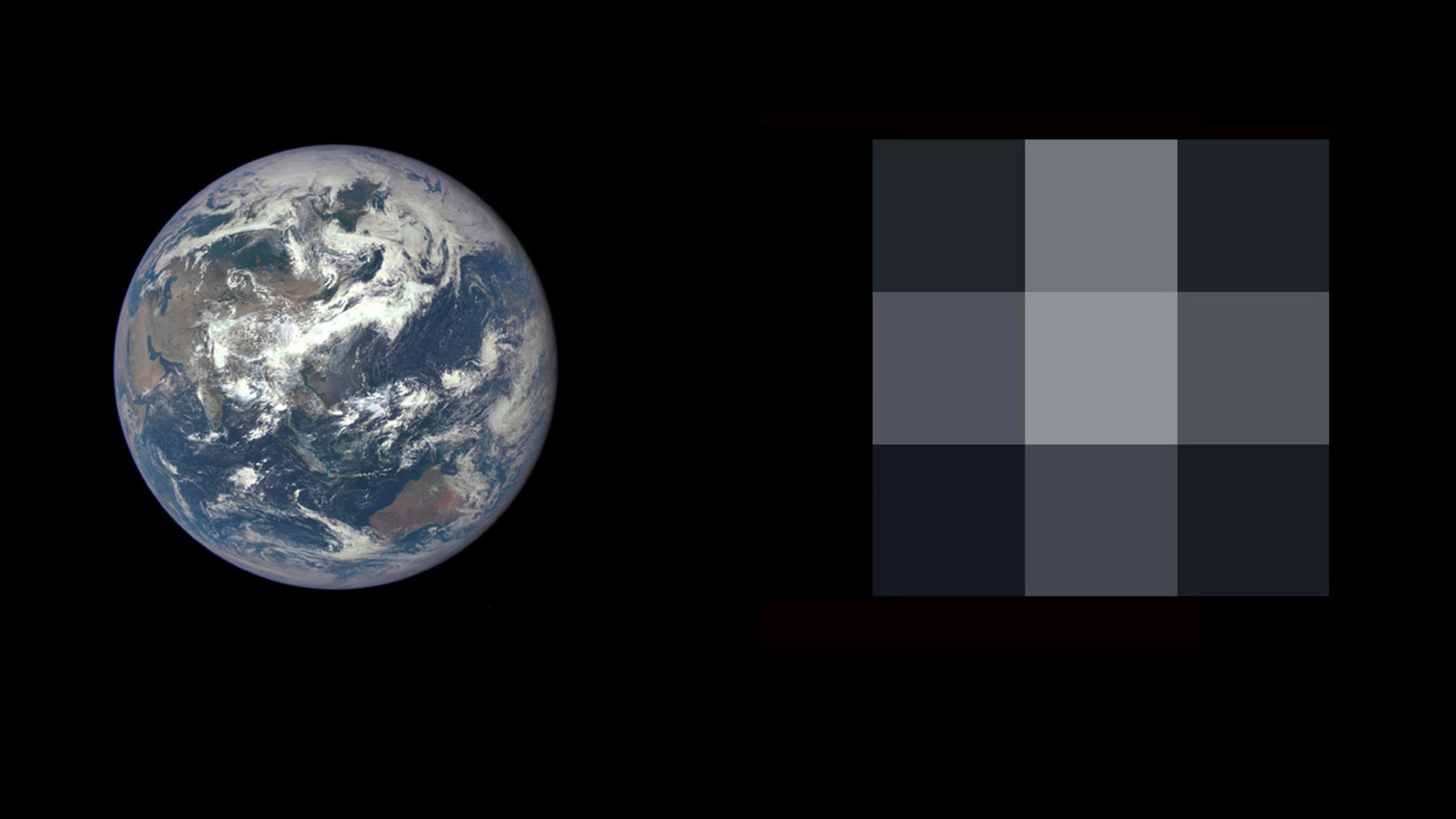
Left, an image of Earth from the DSCOVR-EPIC camera. Right, the same image degraded to a resolution of 3 x 3 pixels, similar to what researchers will see in future exoplanet observations (assuming the light from the central pixel bleeds into adjacent ones). If we were to build a telescope capable of obtaining ~60–70 micro-arc-second resolution, we’d be able to image an Earth-like planet at this level at the distance of Alpha Centauri. Habitable Worlds Observatory, with a novel coronagraph, as well as the ground-based ExoLife Finder, could image Earth-sized worlds at Earth-like distances from Sun-like stars, albeit only as a single pixel.
Habitable Worlds Observatory (HWO) will be at least a 6.0 meter diameter telescope, making it at least comparable in size to JWST, although architectures have been proposed that are even larger: up to 9.0 meters or even greater. Like Hubble and Nancy Roman, it will be an optical-focused telescope, with near-infrared and ultraviolet capabilities as well. It will be serviceable and upgradeable, like Hubble and unlike JWST. And it will be equipped with a state-of-the art coronagraph: one whose capabilities will vastly exceed those of Hubble, JWST, or even Roman, and this will be the key piece of architecture that enables it to meet its prime science goal: of imaging the nearest Earth-sized planets at Earth-like distances around Sun-like stars.
It’s important to emphasize why the combination of its size, wavelength range, and its coronagraphic capabilities enable us to directly image these potential “alien Earths.” If you were to take our own Solar System and place it at a distance of several light-years — a comparable distance to that of the nearest Sun-like stars from us — you could ask the question, “how good would our telescope capabilities need to be to observe planet Earth directly?” It turns out that you’d want a telescope that:
- could observe in ultraviolet, optical, and near-infrared wavelengths (that’s the primary form of light emitted by the Sun and reflected by the Earth),
- had large amounts of light-gathering power,
- was located in space,
- had spectroscopic and photometric imaging capabilities,
- and that was capable of seeing the faint Earth against the glare of the bright Sun.
That last aspect was the big challenge for an observatory like HWO, especially compared against all of its predecessor telescopes.

A circular obstacle placed in front of a source of light, like the supercooled deuterium source shown here, doesn’t simply produce a shadow that blocks the main light source, but rather results in a series of concentric rings and fringes as a result of the wave nature of light and the patterns of constructive/destructive interference that emerge. This presents a challenge for the science of coronagraphy.
Credit: Johnwalton/Wikimedia Commons
If you were to look at the Earth-Sun system from afar, you could imagine putting a circular disk up in front of the Sun, blocking its light in an attempt to see the much fainter Earth despite the tremendous glare of the (much brighter) Sun. But there’s an annoying fact that gets in the way: sure, the Sun may be a circle, but putting up a circular obstacle in front of the Sun won’t just block the sunlight while letting the light from Earth pass through. Instead, the Sun’s light will diffract around the edge of the coronagraphic disk, as light’s dual (including wave-like) nature ensures that instead of just a dark shadow, the Sun’s light will produce a series of rings, a result of interference and diffraction.
It was long speculated that the way to solve this problem would be to leverage the mathematics of different shaped obstacles for blocking a distant star’s light. Rather than a circle, a sunflower-shaped obstacle — if held at a great distance away from the telescope — could block that light in an ideal fashion. Instead of the “edge effects” from the edges of the circle producing a series of wave-like rings, the edge effects from the edges of a sunflower-shaped object would all interfere destructively, permitting the light from any orbiting planet to pass through unaffected. This starshade technology has been looked at as an optically superior alternative to a coronagraph for a long time, but it would come at a cost.

This artist’s concept shows the geometry of a space telescope aligned with a starshade, a technology used to block starlight in order to reveal the presence of planets orbiting that star. From tens of thousands of kilometers away, the starshade and the telescope must achieve and maintain perfect alignment to enable direct exoplanet imaging. Compared to a coronagraph, a starshade’s optics are superior, but far fewer stellar systems can be probed in any given amount of time.
Sure, it would have been optically perfect, but the fact that it would have to be flown literally tens of thousands of kilometers away from the telescope itself represented a tremendous challenge.
- Positioning would need to be exquisite, as the line-of-sight from the telescope to the starshade to the target star would need to be held constant, to better-than-millimeter precision, for hours at a time.
- The starshade would require its own fuel and guidance system (and possibly also its own launch vehicle), and would have to physically move great distances to switch from one target to the next, which would necessitate long periods of time between successive operations.
- The telescope and starshade, in tandem, could only ever observe a small number of target stars at once, lacking the flexibility of a coronagraph to deploy (or de-deploy) at will.
- And the starshade itself would be quite fragile; a tiny micrometeorite passing through it could be catastrophic, as allowing even a tiny bit of starlight through an imperfection could dwarf the critically necessary signal of the target planet.
Remarkably, HWO’s current architecture doesn’t include a starshade at all, but instead relies on steady improvements to coronagraphic technology. This is one case where the technology has advanced even more rapidly than the needed projections! Based on the size and reflectivity of Earth, a coronagraph would need to achieve brightness contrasts of between 10-10 and 10-12 (between 1 part in 10 billion and 1 part in a trillion) to image an Earth-sized world at Earth-like distances around a Sun-like star. And no coronagraph has ever gotten there as of yet.

If the Sun were located at the distance of Alpha Centauri, the future Habitable Worlds Observatory, either with a starshade or a sufficiently advanced coronagraph, would not only be able to directly image Jupiter and Earth, including taking their spectra, but even the planet Venus as well. The farther out giant planets, including Saturn, Uranus, and Neptune, would all be perceptible as well.
But this has been a tremendous endeavor in the field of instrumentation, and one that has seen vast improvements over time. Hubble’s coronagraph, for instance, allows brightness contrasts of around 10-3, or 1-part-in-1000. It enabled us to acquire our first direct images of exoplanets, as well as to image debris disks and protoplanetary disks around young stars.
JWST’s coronagraph is far superior, enabling brightness contrasts of around 10-5: enough to enable it to probe the atmospheres of Neptune-sized worlds around stars just a little bit fainter than the Sun. The advance of a factor of 100 was impressive, but coronagraphy wasn’t the major point of advance for JWST.
Instead, the next proving ground would come with the Nancy Roman telescope, whose coronagraph was hoped — when the mission was proposed — to reach brightness contrasts of ~10-7, or one part in 10 million. However, the team (primarily at JPL in Pasadena, CA) working on developing the coronagraph exceeded expectations, and Roman’s coronagraph should achieve brightness contrasts of at least 10-8 and maybe even approaching 10-9. If all goes well, we should witness it in action, performing science operations, as soon as 2027.
And so coronagraphic performance on HWO should easily reach ~10-10 and might be even better, enabling, for the first time ever, direct images of Earth-sized worlds at Earth-like distances from Sun-like stars.
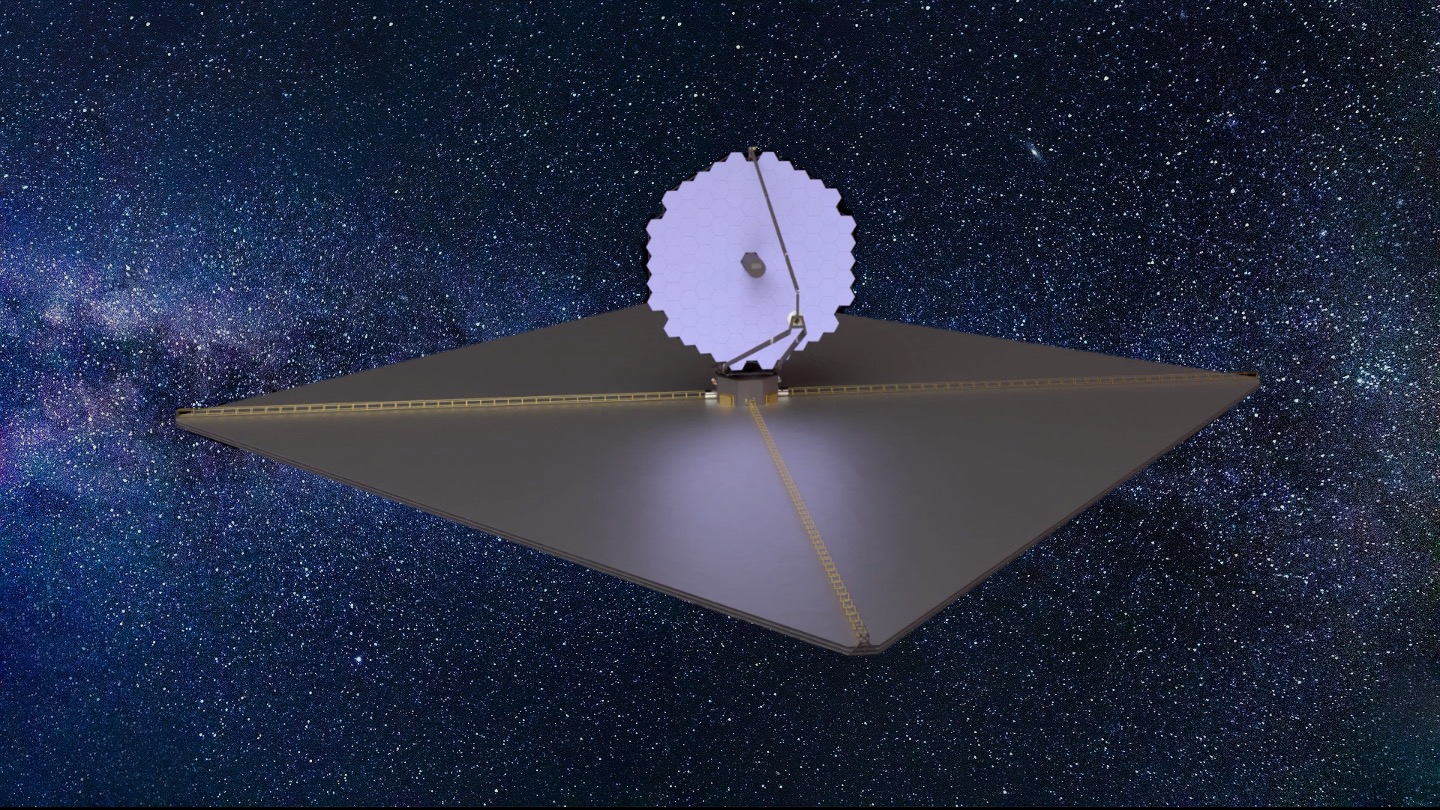
Ideally, the new space telescope Habitable Worlds Observatory, with capabilities between those of the previously-proposed HabEx and LUVOIR (shown here), will be large enough to image a large number of Earth-like exoplanets directly, while still having the desired properties to keep it on-budget and not require the development of wholly new, untested technologies. This observatory, known as Habitable Worlds Observatory, will be NASA’s next flagship mission after the Nancy Roman space telescope.
However, that’s not the end of the story! Sure, we often build observatories with specific science goals in mind, and with instruments and capabilities to meet those particular goals with as much “margin” (or room to exceed the minimum necessary requirements) as possible. But once we design and plan to build that observatory to those specifications, we then ask the big question of, “and if we had such an observatory, what else would it be capable of doing?”
And for HWO, that’s not only where the story gets very interesting, that was also the major topic of conversation that occurred throughout the week-long conference that just took place: what else could we accomplish with an observatory of this caliber? And, as a follow-up to that, what should be our plans, as a community, as we think about the final design of this telescope and what sorts of instruments and capabilities should we outfit it with to maximize the science return from this mission?
After all, although Hubble was designed to measure the Hubble constant, its greatest discoveries (the existence and properties of dark energy, deep field images, discoveries and images of exoplanets, huge finds about supernovae and other cataclysms, etc.) came about because of its unique capabilities and its ability to be a multi-purpose observatory. JWST has been a similar story, as will Roman. So what else could an observatory like HWO do?
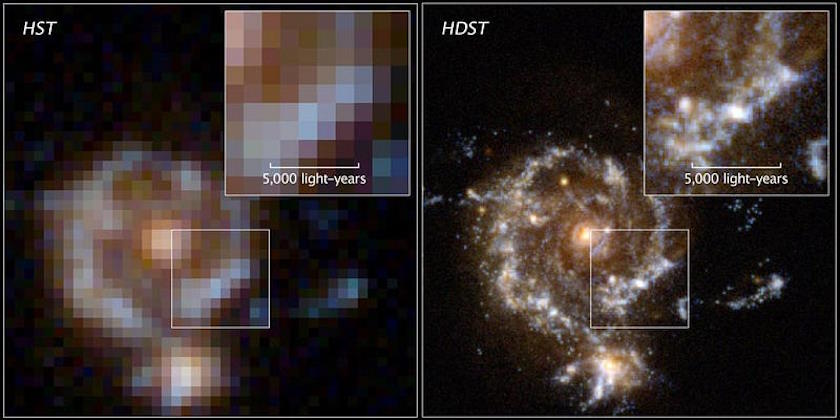
A simulated image of what Hubble would see for a distant, star-forming galaxy (left), versus what a 10–15 meter class telescope like LUVOIR (which is one of the two predecessor designs being incorporated into the Habitable Worlds Observatory) would see for the same galaxy (right). The astronomical power of such an observatory would be unmatched by anything else: on Earth or in space. LUVOIR, as proposed, could resolve structures as small as ~300–400 light-years in size for every single galaxy in the Universe.
This is always a fun game to play, because we’re only ever going to pick out the bits of science that we know, in advance, such an observatory would be capable of. But it’s worth keeping in mind that we’re going to uncover new use cases — identifying questions we can answer that we don’t even know to ask yet — as we continue to conduct cutting-edge science, revealing new classes of objects, environments, and phenomena along the way.
That said, a larger telescope sensitive to the same wavelength ranges as Hubble and Roman, outfitted with superior instruments, is definitely going to achieve higher resolutions than ever before. Its resolution will even outstrip those achievable by the comparably-sized JWST, because resolution isn’t just about the size of your telescope, but the number of wavelengths of light (of the type of light you’re choosing to look at) that fit across your telescope’s primary mirror.
For HWO, it will have comparable resolution to JWST in the near-infrared, superior resolution in the optical, and vastly superior resolution in the ultraviolet. Whereas Hubble and JWST can image galaxies from all across the Universe, HWO would be able to image them at resolutions of a few hundred light-years per pixel for every galaxy within the observable Universe.

From a visual perspective, Hubble’s view of Arp 143 makes perhaps its most striking and beautiful image of 2022. The pair contains the glittery, distorted, star-forming spiral galaxy NGC 2445 at right, along with its less flashy companion, NGC 2444 at left. The resolutions achievable here, for a nearby galaxy with Hubble, would be comparable to the resolution achieved for a similar galaxy up to ten times as far away with HWO, if viewed in short (UV) wavelengths of light.
Credit: NASA, ESA, STScI, Julianne Dalcanton Center for Computational Astrophysics, Flatiron Inst. / UWashington); Processing: Joseph DePasquale (STScI)
One of the interesting (but underappreciated) aspects of HWO is that it has room for four instruments, and only three of those instrument slots have had instruments selected for them already. The one remaining slot could be used to extend HWO’s capabilities into the far-UV, enabling it to probe the narrow, short wavelength ranges that fall outside of even the range of Hubble or Roman. At shorter wavelengths, even higher resolutions would be achievable, and so we could map out individual star-forming regions within any galaxy we chose within the entire observable Universe. We could also perform spectroscopy on them, identifying what species of molecule are present, in what abundance, and at what temperature/state of ionization within those regions.
This observatory would also be more exquisitely sensitive than any of its predecessor observatories, and could identify features in and properties of distant galaxies that are, at present, only possible for the closest galaxies to us or even restricted to being inside the Milky Way. The scientific fields of:
- star-formation,
- planet formation,
- microlensing,
- galaxy classifications,
- exoplanet and exomoon sciences,
- the study of the circumgalactic medium,
- gas stream collisions,
- tidal streams from interacting galaxies,
- plus individual cataclysms like novae, kilonovae, tidal disruption events, and supernovae,
should all advance tremendously with this new observatory, as well as in many other adjacent fields.
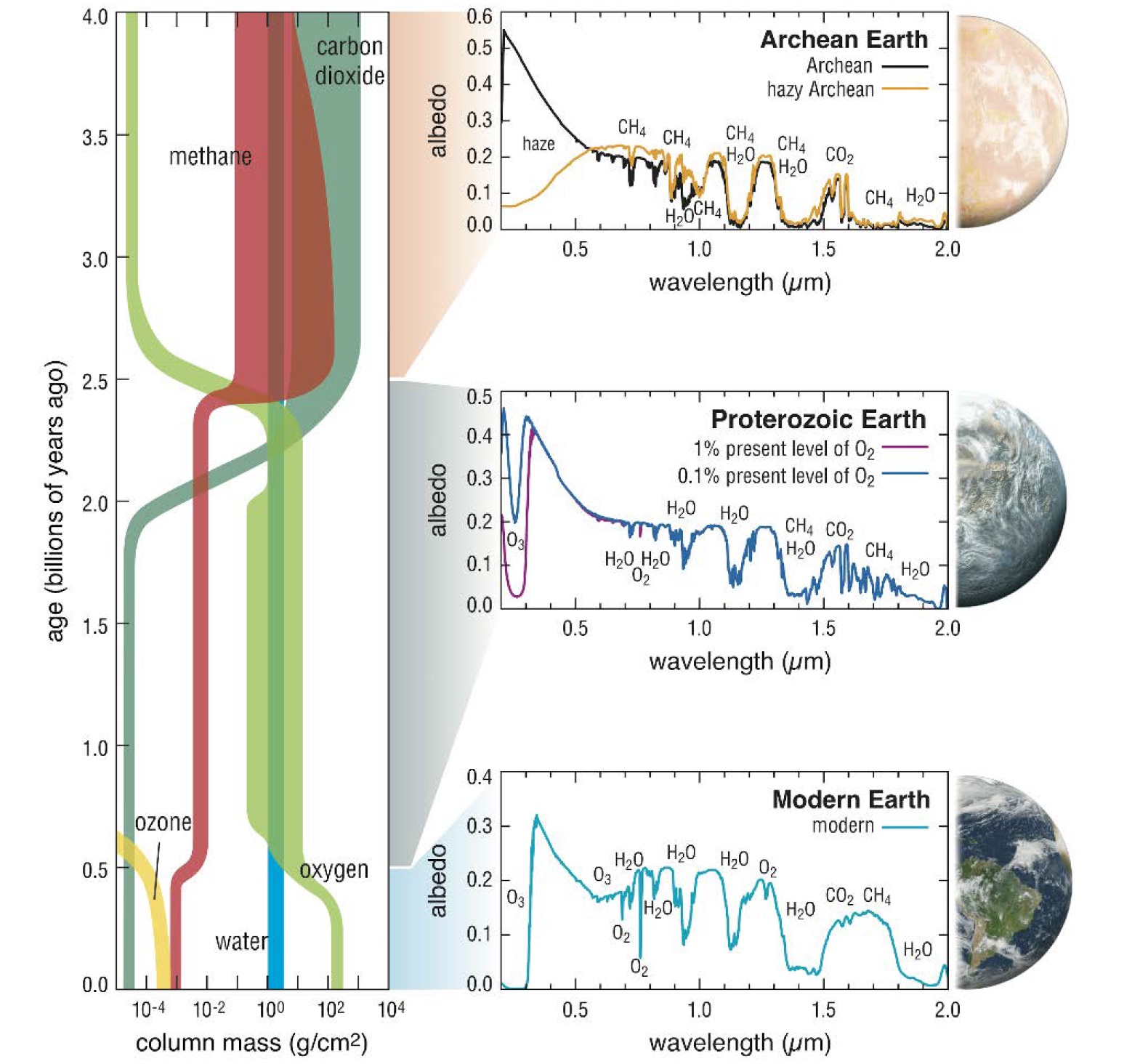
The prospect of detecting and characterizing the atmosphere of a true Earth-like planet, i.e., an Earth-sized planet in the habitable zone of its star, including both red dwarf and more Sun-like stars, is within our reach. With a next-generation coronagraph, a large ultraviolet-optical-infrared mission could find dozens, or even hundreds, of Earth-sized worlds to measure.
But there was also a pall over the entire HWO conference, and the anxiety among all of the presenters was palpable, as no one in attendance could offer any reassurances that:
- the scientifically meritorious plan, and the overwhelming science case in favor of building HWO and its components, would actually mean the observatory will get funded, designed, and built,
- that it would be able to remain as a NASA mission, as many of the people and facilities that support these flagship space telescopes are at risk of being terminated,
- that funding streams for the telescope, including from the US government and also including its partner agencies, universities, and institutes, would remain intact and undisturbed,
- and that the next generation of scientists, including early career researchers (undergraduate students, graduate students, postdoctoral researchers, and scientists at national labs and institutes), would be supported so that they can take the reins of running this telescope if it flies and becomes operational in the 2030s, as planned.
The sober truth is that thousands of experienced NASA employees have already either been fired or have accepted offers, often accompanied with threats, to retire early or otherwise acquiesce to a reduction-in-force. Funding for science centers that support these missions, like NASA Goddard and the Space Telescope Science Institute, has been repeatedly threatened, and many researchers have already lost faith that the US government can ever again be, year-after-year, a reliable funding source or partner for fundamental science.

This animation switches between the planned NASA astrophysics fleet, as originally published by NASA in December of 2016, and the current budget proposal for the 2026 fiscal year for NASA astrophysics. With only a few notable exceptions, the entire portfolio of NASA astrophysics missions is slated to be eliminated.
We have a golden road laid out before us for taking the next great scientific leap forward into the Universe. The 20th century was the one that saw us discover what rules governed the Universe, what it was made of, where it came from, and how it got to be the way it is today. The 21st century could be the one where we first find life beyond our own Solar System, answering the question of “are we alone?” with an emphatic “no” for the first time in history. But the great concern is that it instead becomes the century where we abandon fundamental science and basic research, leading instead to stagnation and a regression into ignorance and darkness as never before.
Will the Habitable Worlds Observatory come to fruition, serving as flagship mission for the future of NASA science, or will it mark the end of NASA’s and the US’s greatness in science, and serve as the centerpiece of the funeral of American science? The next few months and years will be critical in determining which direction — forward into the future or backward into a new dark age — the country, and arguably the world, will head.
Sign up for the Starts With a Bang newsletter
Travel the universe with Dr. Ethan Siegel as he answers the biggest questions of all.
Source link
